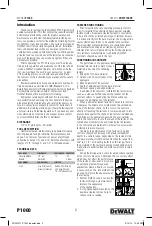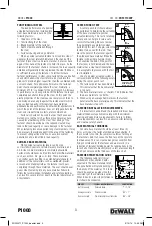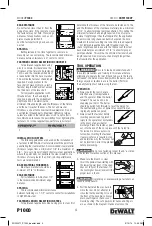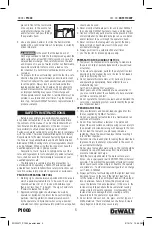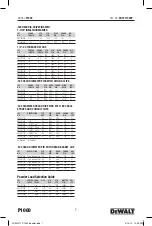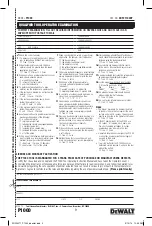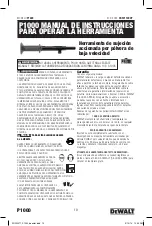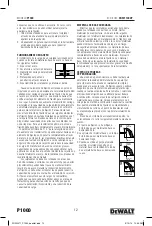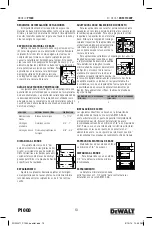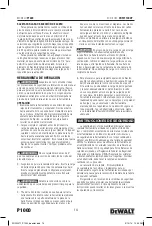
Model
P1000
Cat. No.
ddF211000P
P1000
3
FuncTioning in STeel
the load performance of a powder
actuated fastener when installed into
steel base materials is based on the
following factors:
1. thickness of the steel
2. tensile strength of the steel
3. shank diameter of the fastener
4. depth of point penetration through
the steel
5. fastener spacing and edge distance.
when a powder actuated fastener is driven into steel, it
displaces the steel laterally 360˚ around the shank of the
fastener. since steel is an elastic material, it presses back
against the shank of the fastener to hold it in place. as the
diameter of the fastener shank is increased, the load capacity
obtained will generally increase provided the steel thickness
is sufficient to accept the fastener. to further increase
fastener performance in steel, some fasteners have a knurled
shank which allows the steel to form a key lock into the
grooves to provide higher capacities than those obtained with
a smooth shank. for optimum performance, the fastener
point should completely penetrate the steel. normally, a
minimum of 1/4” is allowed for the point length. an increase
in performance can be expected until the fastener no longer
completely penetrates through the steel. at this point, the
elastic properties of the steel cause a compression force to
be developed at an angle against the fastener point which
reduces load capacity. in thicker steel base materials,
adequate load capacities may be obtained for applications in
which the point of the fastener does not fully penetrate the
steel. job site performance tests are recommended.
fasteners should not be used in areas that have been
welded or cut with a torch as these procedures may have
caused local hardening of the steel. over driving of the
fastener should be avoided as the rebound created may
reduce the load capacity or cause damage to the fastener.
when fastening into unsupported long steel members, it may
be necessary to provide support in the area of the fastening
to prevent spring action which can cause inconsistent
penetration and a reduction in load capacity.
SuiTaBle BaSe MaTeRial
while powder actuated fasteners can be used
successfully in concrete, certain masonry materials, and
a 36 steel, some materials are completely unsuitable.
fasteners should never be fired into hard or brittle materials
such as cast iron, tile, glass, or rock. these materials
can shatter easily resulting in a potential safety hazard. in
addition, soft base materials such as wallboard, plaster,
or wood are not appropriate as the fastener could pass
completely through these materials. the user should never
guess when fastening into any base material. failure to
follow the recommended installation and safety guidelines
can result in severe injury or death to the tool operator and/
or bystanders.
cenTeR punch TeST
a center punch test should always
be performed to determine the suitability
of the base material for a powder
actuated fastening. this test is relatively
simple and can help to insure a safe,
successful fastening. be sure to wear
the appropriate eye protection when
performing this test. to begin, select the
fastener to be used for the job. then,
place the point of the fastener against
the proposed base material. strike the
fastener with a single hammer blow,
then examine the point. if the point of
the fastener is not blunted and the base
material has a clear point indentation,
it is acceptable to proceed with the first
test installation.
use of a powder actuated system is
not recommended if the following occurs
during the center punch test:
1. the fastener point has been blunted.
this indicates that the base material
is too hard.
2. the base material cracks or shatters. this indicates that
the base material is too brittle.
3. when using an average hammer blow, the fastener
penetrates the base material easily. this indicates that the
base material is too soft.
FaSTeneR inSTallaTion RequiReMenTS
it is important to understand the required minimum base
material thickness requirements along with the minimum
spacing and edge distance requirements. failure to follow
these requirements can result in an unsuccessful fastening
and create a safety hazard.
BaSe MaTeRial ThickneSS
concrete base material should be at least three (3)
times as thick as the fastener embedment penetration. if
the concrete is too thin, the compressive forces forming at
the fasteners point can cause the free face of the concrete
to break away. this can create a dangerous condition from
flying concrete and/or the fastener and also results in a
reduction of fastener holding power. for applications in the
face shell of concrete masonry block, select a fastener length
which will not exceed the thickness of the face shell.
FaSTeneR peneTRaTion guiDe
the following table lists typical
embedment or penetration depths
expected in the base materials listed.
the penetration will vary depending on
the density of the material. this table
should be used as a guide since the
consistency of these materials varies.
when in doubt, a job site performance
test should be conducted.
DenSiTy
Typical BaSe MaTeRial
peneTRaTion
soft masonry
concrete block
1” – 1-1/4”
average concrete
Poured concrete
3/4” – 1”
dense concrete
Pre-stressed/pre-cast concrete
5/8” – 3/4”
Point
Flattens
No
Indent
Surface
Shatters
Material
Cracks
Fastener Sinks in
with Average
Hammer Blow
2
3
1
Penetration
3x
Penetration
POW2271_P1000_booklet.indd 3
3/10/14 12:43 PM
Содержание DDF211000P
Страница 30: ...P1000 Model P1000 Modelo P1000 ModÈlE P1000 30 POW2271_P1000_booklet indd 30 3 10 14 12 43 PM ...
Страница 31: ...P1000 Model P1000 Modelo P1000 ModÈlE P1000 31 POW2271_P1000_booklet indd 31 3 10 14 12 43 PM ...
Страница 32: ...P1000 Model P1000 Modelo P1000 ModÈlE P1000 32 POW2271_P1000_booklet indd 32 3 10 14 12 43 PM ...


